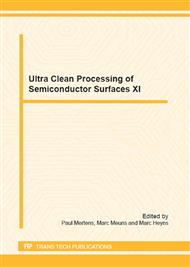p.154
p.161
p.165
p.169
p.173
p.177
p.181
p.185
p.191
Towards an Improved Megasonic Cleaning Process: Influence of Surface Tension on Bubble Activity in Acoustic Fields
Abstract:
Removal of particulate residues represents a very challenging step in current CMOS-technology nodes. The continued miniaturization and the introduction of novel materials in the semiconductor industry have resulted in very stringent requirements for device fabrication steps such as cleaning processes [. Physical forces, acting directly on the surface to be cleaned, are currently employed for delicate particle removal as an alternative to more aggressive chemistries [2]. High frequency ultrasounds (500 kHz 4 MHz), or megasonics, rely on the action of oscillating bubbles created during the ultrasonic agitation of the cleaning liquid. Strongly oscillating gas bubbles are able to generate shear forces, which are considered to be responsible for cleaning [3]. However, collapsing bubbles close to a surface can also produce water jets and shockwaves which lead to damage of fragile structures. Fundamental research is needed in order to overcome these issues by improving the understanding of the physical parameters playing a role in the acoustic cavitation of bubbles. This study reports the effects of lowering the surface tension of the liquid bulk on the bubble activity in the MHz range. A lower surface tension (45 mN/m) with respect to water (72 mN/m) is obtained by adding a non-ionic surface-active agent (TritonX-100). After fully characterizing its wettability, a cleaning solution containing surfactant is investigated under pulsed and continuous acoustic fields, for different acoustic amplitudes and gas concentrations. The aim is to increase bubble activity while reducing the strength of the bubble collapse. The results obtained can be useful in tuning megasonic cleaning systems towards more efficient processes.
Info:
Periodical:
Pages:
173-176
Citation:
Online since:
December 2012
Price:
Сopyright:
© 2013 Trans Tech Publications Ltd. All Rights Reserved
Share:
Citation:


